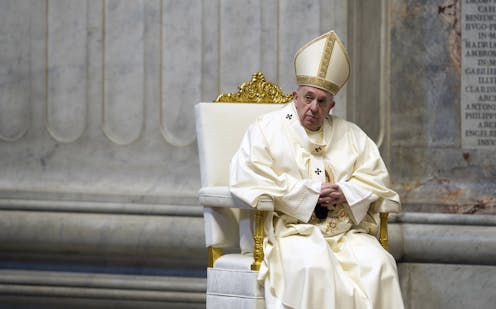How limiting Latin Mass may become the defining moment for Pope Francis
Pope Benedict XVI expanded the Latin Mass in 2007 in an olive branch to traditionalists. His successor hopes reversing that decision may better serve unity in the church.

Pope Francis took sudden steps on July 16, 2021, to curtail the traditional Latin Mass, in an abrupt reversal of his predecessor’s policy.
To non-Catholics – and many Catholics – the decision may seem on first glance to be a technical, even obscure action not worth very much attention.
But it sent shock waves through the Roman Catholic Church. As a scholar who studies the Catholic Church’s relationship to the world, I believe the move may be the most important action Francis has taken in an eventful papacy.
A history of the Mass
The Mass is the central act of Roman Catholic worship. During the earliest centuries of Christianity, there was widespread variation in the Mass. Local irregularities thrived at a time before printed books, and easy communication, were available.
But after the Reformation of the 16th century split the Western Church in two, the Roman Catholic Church regularized the form and the language of the Mass. At the Council of Trent, a gathering of Catholic bishops in northern Italy between 1545 and 1563 prompted by the rise of Protestantism, the Mass was codified. Disseminating the new rules to churches across Europe was made easier with the help of the newly invented printing press.
From that time, the ordinary celebration of the Mass followed a precise format that was set forth in printed books – and was always celebrated in Latin.
This Mass held firm in Catholic life for 400 years.
That was until the Second Vatican Council of 1962 to 1965. Also known as Vatican II, the council was convened to address the position of the Catholic Church in the modern world. Vatican II decreed that Catholics should be full, active participants in the Mass. Among other changes favoring that decree, the Mass was to be translated into local languages.
But before long, some Catholics began to express misgivings about the new rules regarding Mass, fearing that it changed too much by upending centuries of tradition.
One of them was French Archbishop Marcel Lefebvre, who refused to conduct the Mass in anything other than Latin, saying, “I prefer to walk in the truth without the Pope than to walk a false path with him.” On another occasion he commented: “Our future is the past.”
How call to unity backfired
In 1976, Pope Paul VI suspended Lefebvre from acting as a priest. Lefebvre responded by defying the pope to form his own school in Switzerland where seminarians could be trained in the pre-Vatican II Mass.
Paul VI’s successor, Pope John Paul II tried to mend fences with Lefebvre and his followers, but ended up excommunicating him in 1988 after the aging Lefebrve ordained four bishops to continue his movement.
Lefebvre’s death in 1991 did not end the movement to return to the Latin Mass.
Although the traditionalist movement was not particularly large, it remained persistent. In 2007, Pope Benedict XVI expanded the use of the traditional Latin Mass. In an apparent olive branch to traditionalists, Benedict said at the time that everyone “has a place in the church.”
After consulting with bishops around the world, Pope Francis has now concluded that Benedict’s approach backfired. Expansion of the Latin Mass had, in Francis’ words, been “exploited to widen the gaps, reinforce the divergences, and encourage disagreements that injure the Church, block her path, and expose her to the peril of division.” As a result, the pope announced rules including preventing bishops from authorizing any new group wishing to use the Latin Mass, requiring them to personally approve any use of the Latin Mass, and preventing groups wishing to use the Latin Mass from worshipping at regular churches. This is more or less a return to the conditions before Pope Benedict acted.
‘What we pray is what we believe’
The history of the Latin Mass controversy is important to understand the position in which Pope Francis found himself and the Catholic Church. But some other things are important, too.
There is a saying in Catholic theology: “Lex orandi, lex credendi.” Loosely translated, it means that “what we pray is what we believe.”
This means that prayer and the Mass are not isolated realities. How Catholics conduct the Mass says something about what Catholics believe. And since Pope Benedict widened the Latin Mass’ availability, two different ways of praying had begun to signify two different, competing communities within the Catholic Church.
Many people prefer the Latin Mass purely for its beauty, and not all of those people are uncomfortable with Pope Francis’ leadership. But many traditionalists are, and their views are not confined to prayer and Mass. The worldview that many in the traditionalist movement share with someone like Archbishop Lefebvre, who supported such far-right political leaders as Jean-Marie Le Pen in France, Spain’s Francisco Franco and Augusto Pinochet in Chile, is very uncomfortable with the modern world. It does not fit with Francis’ vision of a Catholic Church aligned with open societies and on the side of the oppressed.
Traditionalists opposed to Pope Francis have found a refuge inside communities that celebrate the Latin Mass. It has insulated them from the direction in which Francis has been trying to take the church.
Restricting the traditional Latin Mass as he has, it seems that that Pope Francis is challenging traditionalists to be part of the same church as he is.
Schism or not, a defining moment
Some people have wondered whether Pope Francis will cause a schism, a permanent division in the church, with the new ruling.
[Over 100,000 readers rely on The Conversation’s newsletter to understand the world. Sign up today.]
That seems like the wrong question. In my view, the divisions were already there and would remain there whether or not Francis limited the traditional Latin Mass.
The church unity Pope Benedict had hoped would follow the expansion of the traditional Latin Mass has not happened, the Vatican has concluded. How traditionalists respond to Francis’ new restrictions will tell us much about the church’s future – and may prove to be the defining moment of the Francis papacy.

Steven P. Millies does not work for, consult, own shares in or receive funding from any company or organization that would benefit from this article, and has disclosed no relevant affiliations beyond their academic appointment.
Read These Next
From truce in the trenches to cocktails at the consulate: How Christmas diplomacy seeks to exploit s
World leaders like to talk up peace at Christmastime. But alongside the tales of seasonal breaks in…
As DOJ begins to release Epstein files, his many victims deserve more attention than the powerful me
Powerful men connected to Jeffrey Epstein are named, dissected and speculated about. The survivors,…
The world risks forgetting one of humanity’s greatest triumphs as polio nears global eradication − 7
Polio may finally be defeated in the next 5 years. Will the world recognize what an extraordinary achievement…





